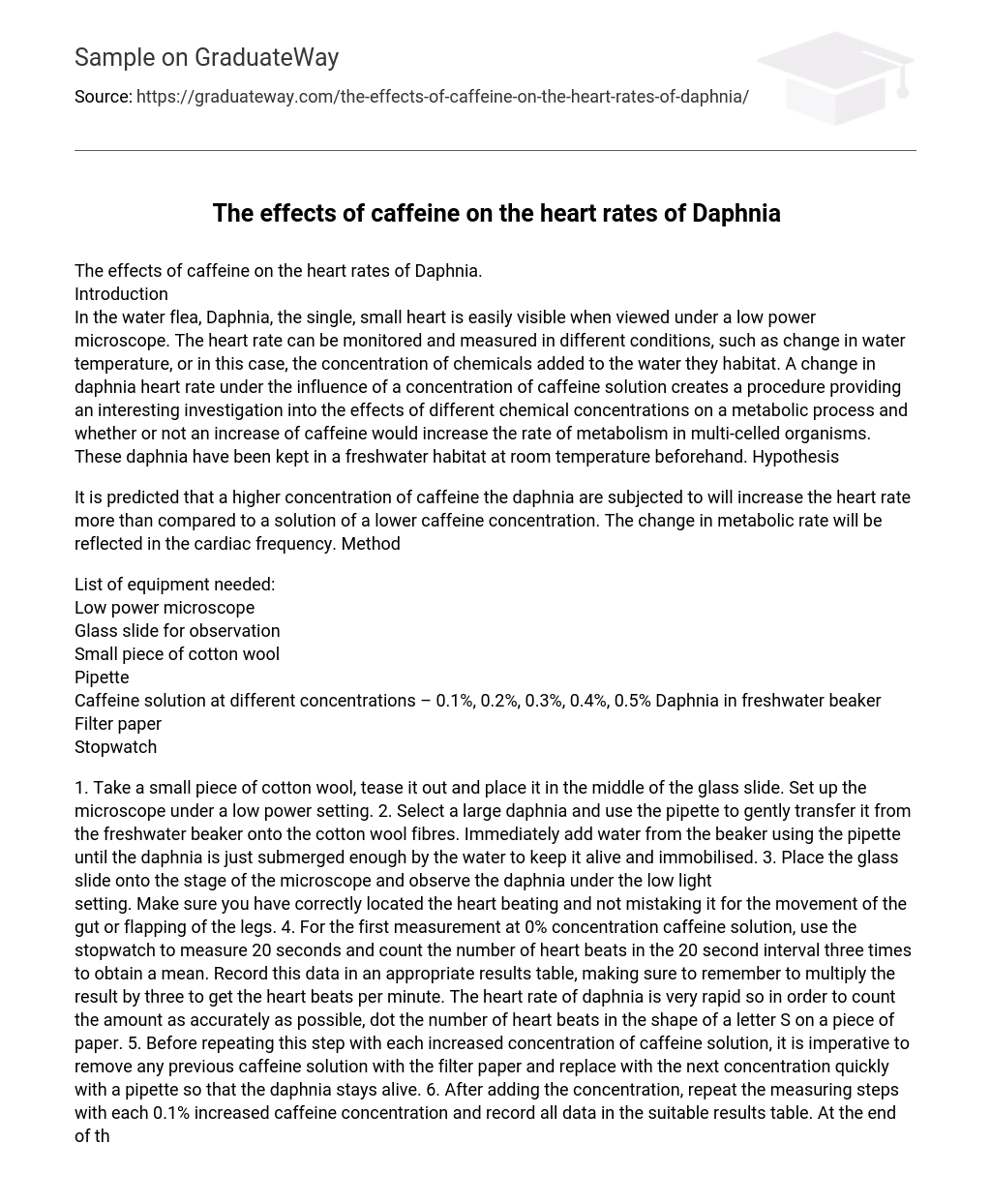Introduction
In the water flea, Daphnia, the single, small heart is easily visible when viewed under a low power microscope. The heart rate can be monitored and measured in different conditions, such as change in water temperature, or in this case, the concentration of chemicals added to the water they habitat. A change in daphnia heart rate under the influence of a concentration of caffeine solution creates a procedure providing an interesting investigation into the effects of different chemical concentrations on a metabolic process and whether or not an increase of caffeine would increase the rate of metabolism in multi-celled organisms. These daphnia have been kept in a freshwater habitat at room temperature beforehand.
Hypothesis
It is predicted that a higher concentration of caffeine the daphnia are subjected to will increase the heart rate more than compared to a solution of a lower caffeine concentration. The change in metabolic rate will be reflected in the cardiac frequency.
Method
List of equipment needed:
Low power microscope
Glass slide for observation
Small piece of cotton wool
Pipette
Caffeine solution at different concentrations – 0.1%, 0.2%, 0.3%, 0.4%, 0.5% Daphnia in freshwater beaker
Filter paper
Stopwatch
1. Take a small piece of cotton wool, tease it out and place it in the middle of the glass slide. Set up the microscope under a low power setting.
2. Select a large daphnia and use the pipette to gently transfer it from the freshwater beaker onto the cotton wool fibres. Immediately add water from the beaker using the pipette until the daphnia is just submerged enough by the water to keep it alive and immobilised.
3. Place the glass slide onto the stage of the microscope and observe the daphnia under the low light setting. Make sure you have correctly located the heart beating and not mistaking it for the movement of the gut or flapping of the legs.
4. For the first measurement at 0% concentration caffeine solution, use the stopwatch to measure 20 seconds and count the number of heart beats in the 20 second interval three times to obtain a mean. Record this data in an appropriate results table, making sure to remember to multiply the result by three to get the heart beats per minute. The heart rate of daphnia is very rapid so in order to count the amount as accurately as possible, dot the number of heart beats in the shape of a letter S on a piece of paper.
5. Before repeating this step with each increased concentration of caffeine solution, it is imperative to remove any previous caffeine solution with the filter paper and replace with the next concentration quickly with a pipette so that the daphnia stays alive.
6. After adding the concentration, repeat the measuring steps with each 0.1% increased caffeine concentration and record all data in the suitable results table. At the end of the experiment, carefully return the daphnia to the freshwater beaker.
Safety Considerations
The likelihood of the glass slide breaking during the experiment is quite common due to the fragility of the thin slide. If shattered, the glass slide can become a danger in the science lab. To prevent any broken glass, handle all glassware with care. Microscopes are heavy and delicate equipment. In order to prevent equipment damage or injury from a knocked over microscope, ensure the base is stable and not close to the table edge. Also make sure that you are standing so that you are more likely to move out of harm’s way.
Variables
Independent variable – the percentage concentration of caffeine solution given to the daphnia Dependent variable – the heart rate of the daphnia per minutes in bpm Control variables – the daphnia subjected to the caffeine, the volume of caffeine solution added, the ambient temperature, the light intensity of the microscope, the person recording the heart rate of the daphnia and the person measuring 20 seconds on the stopwatch.
Validity
I believe this test will be valid as I am remaining consistent with my methods throughout and not drastically changing my method in any way. By sticking to my control variables and making sure these aren’t corrupted will keep my experiment’s validity high. I also believe my ranges of measurements are suitable to the experiment as they comply well with my hypothesis, wanting to see how delicate the daphnia are when subjected to varying levels of caffeine. This means my results will not be affected by inconsistency.





